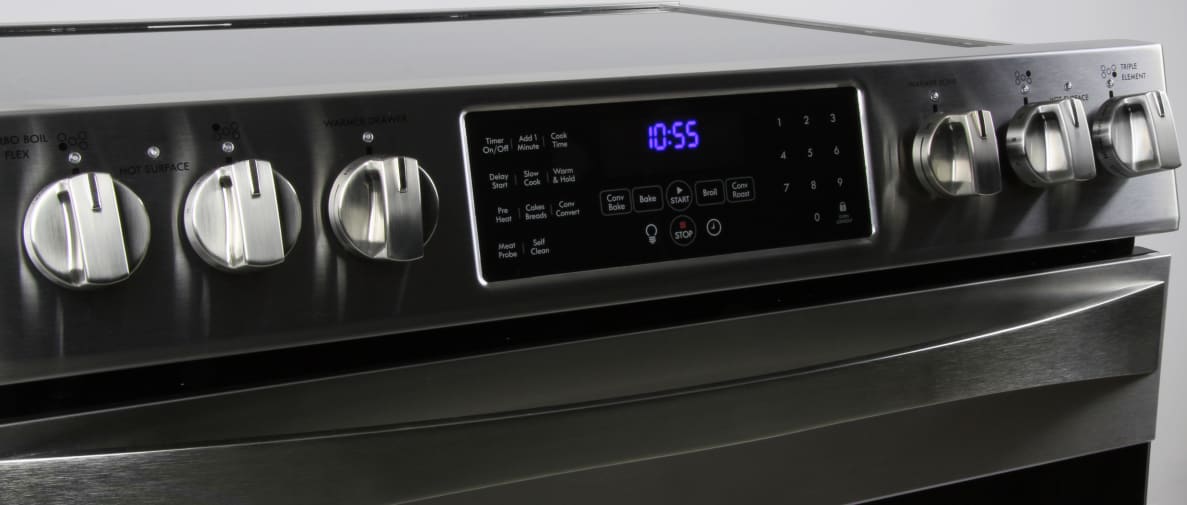Pros
Cons
When we first saw the Kenmore Elite 41313 (MSRP $2,599.99) 30-in. freestanding electric range last year, we were impressed. It's the latest contender among a growing number of slide-in style ranges that promise both sleek looks and easy installation.
In addition to its attractive appearance, it offers a ton of different oven cook modes and convection, and did well across all of our tests. That's not surprising. It's built by Frigidaire, who makes many of our best-scoring ranges.
However, a 4.6-cu.-ft. oven capacity and a $2,199 sale price make it a tough sell against the similarly styled LG LSE3090ST, which can be found for just under $1,499. For just $1,799, you can get the attractive and innovative 5.8 cu. ft. Samsung NE58F9710WS. In addition to good looks and performance, only the Samsung features a Flex Duo divider that lets users switch between a single- and dual-cavity oven.
We wanted to like this Kenmore—we really did! It's a great choice for a streamlined kitchen remodel, and it baked and boiled like a champ. But with so many competitors on the market selling for hundreds less, we can only recommend it if the price drops significantly.
UPDATE: As of June 29, 2015, the price on this range has dropped to $1,699 at Sears. That makes it a considerably better value. If you're shopping for a freestanding electric range with a slide-in look, we now recommend you check out this Kenmore. Just make sure to wait for a sale price.
Design & Usability
Sleek in appearance, with a bounty of options
The 30-in. 41313 is billed as a freestanding range with a built-in look, and there’s no denying it has a sleek appearance. Like all freestanding ranges, it can be installed almost anywhere. Unlike most freestanding ranges, it has front-mounted controls and no backsplash, which give it the unified look of a slide-in range. Because it's 28.97 inches deep, however, it doesn't require a homeowner to make modifications to a countertop, as most slide-ins do.
The oven door may not be entirely covered in steel, but the warming drawer and control panel both sport that unmistakable stainless sheen. The 4.6 cu.-ft. oven houses three racks, while the ceramic glass electric rangetop has four electric burners and a rear central radiant warmer zone.
{{ photo_gallery name="Design" }}
All the controls are located on the front of the range. The electronic oven control panel is set in the center, with rangetop's control knobs placed on either side. The panel is angled for easier viewing, but in the wrong light it's still a bit tough to read the oven cooking modes without bending over.
Those who can see them will note a wide variety of oven settings, including Preheat, Bake, Convection Bake, Convection Roast, Slow Cook, Warm & Hold, Cakes or Breads, a temperature-adjustable Broil, and even a meat probe option. (Phew!) The 41313 also has a timer, a Self Clean cycle that you can set to run between two and four hours, and a Recipe Recall feature that saves your favorite settings. For folks who want to experiment with convection cooking but don't have a firm grasp of how it works, there's a Convection Convert function that should make the necessary time-to-temp adjustments for you.
Rangetop
Almost too hot
The rangetop is about as versatile as they come. Two rear burners each bring 1,200W worth of heat, while the front of the rangetop boasts a 3,200W burner and a 3,000W tri-ring burner that can fit three different cookware sizes.
All but the front-left burner got up to steak-searing, wok-warming temperatures between 629°F and 696°F within 5 minutes. That’s actually a tad hotter than we like, as it surpasses the flash point of cooking oil. This rangetop is pretty darn powerful, so you'll want to remain attentive when cooking on it at high heats.
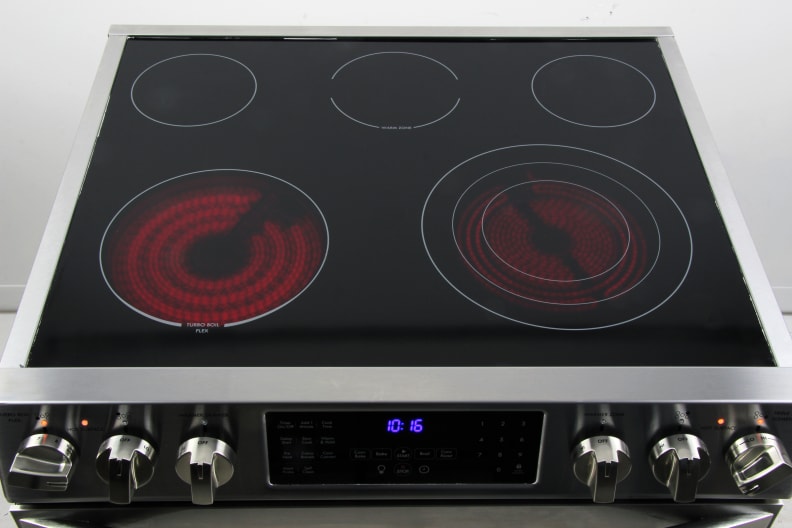
Stick to the front of the range when you’re boiling and you shouldn’t have a problem.
Now, back to that front left burner: Kenmore describes it as a "Turbo Boil Flex Burner" capable of quick boils and low simmers. However, 3,200W of power pushes its max temp uncomfortably high, peaking at a scalding 746°F during our 5-minute test. Generally speaking, you won't need to cook at heats this high, so exercise caution—and maybe keep your stir fry on the other burners.
That said, the front left burner is also capable of reaching an exceedingly low minimum temp of 78°F, which makes it the burner for simmering soup or softening butter. You can’t do much cooking at 78°F, but it proves just how phenomenally wide this burner's temperature range is.
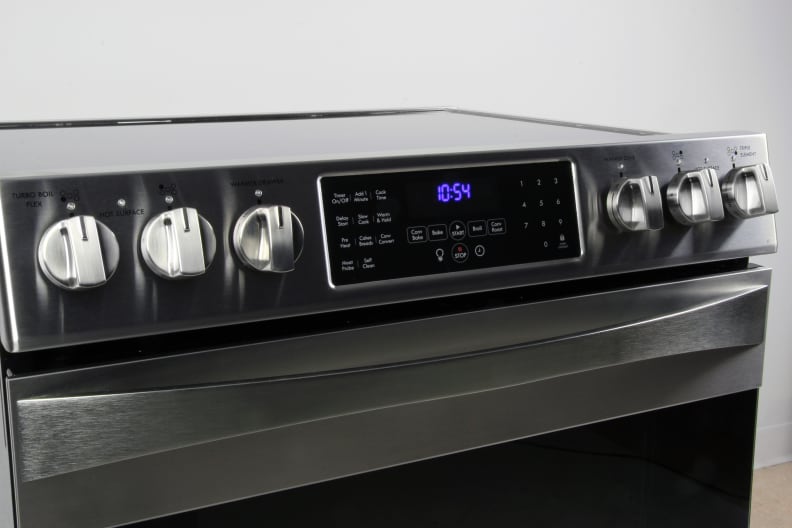
The control panel is angled for easier viewing.
We were impressed with low temperatures on the other burners as well, which fell within a more useful spread of 105°F to 151°F. Take your pick—they're all good for simmering sauces and melting chocolate.
Unsurprisingly, the versatile front left burner was great at rapidly boiling water, heating six cups in just over five minutes. But it was only the second-fastest burner on the range, with the front right burner's outer ring heating the same amount of water in just three and a half minutes.
You’ll want to avoid the slow rear burners when boiling, but how often do you need to boil two pots at once? The 41313 provides two speedy burners, as well as extreme heat and gentle lows—that's pretty much all you need for rangetop cooking.
Oven, Broiler, & Convection
A mixed bag
The good news: The 41313's oven has dual convection fans for even baking, and we found no major performance issues in our tests. The bad news: 4.6 cu. ft. is on the small side for ovens today, and the 41313's competitors are as large as 5.8 cu. ft.
During testing, the standard bake setting produced cookies with pale tops and golden bottoms, a variation in browning that was repeated in every cookie on the baking sheet. Cakes varied more noticeably depending on their location in the oven.
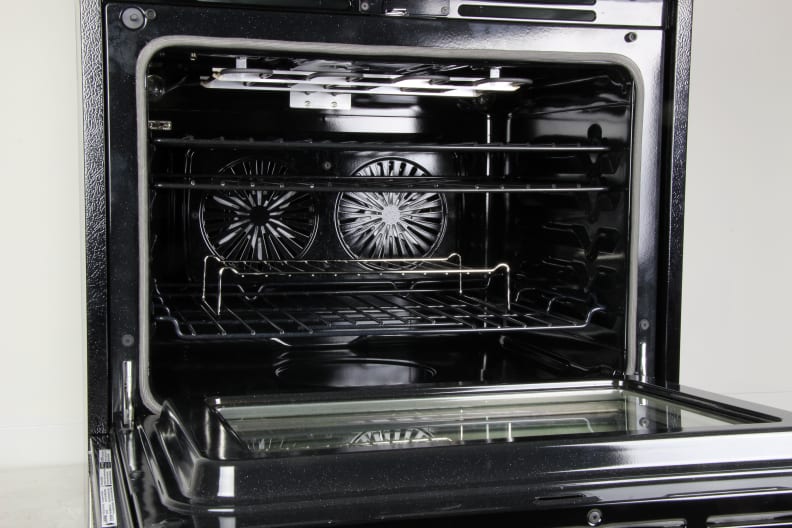
The 4.6 cubic-foot oven may be on the small side, but what it lacks in size it makes up for in cooking performance.
The 41313’s dual true convection system really improved the quality of the already-excellent cookie results, but did less for cakes. Cookies displayed near-perfect evenness uniformly across the baking sheet. Individual cakes browned slightly less evenly than in the standard bake setting, though variation was slightly more consistent compared to the regular Bake mode.
Neither of these changes are significant enough to make a huge difference, so if you’re baking an item for a longer period of time, you may want to consider turning your pan 180° halfway through baking to counteract the left-to-right unevenness.
We tried roasting a pork loin using both the Bake and Convection Roast settings. Standard Bake produced a moist roast that cooked through quickly, but browned very unevenly. Convection Roast produced exceedingly dry pork, but it cooked through about as quickly as the roast we made using the Bake setting, and it was far more evenly browned on the outside. Convection may have produced a prettier product, but who wants to eat dry pork?
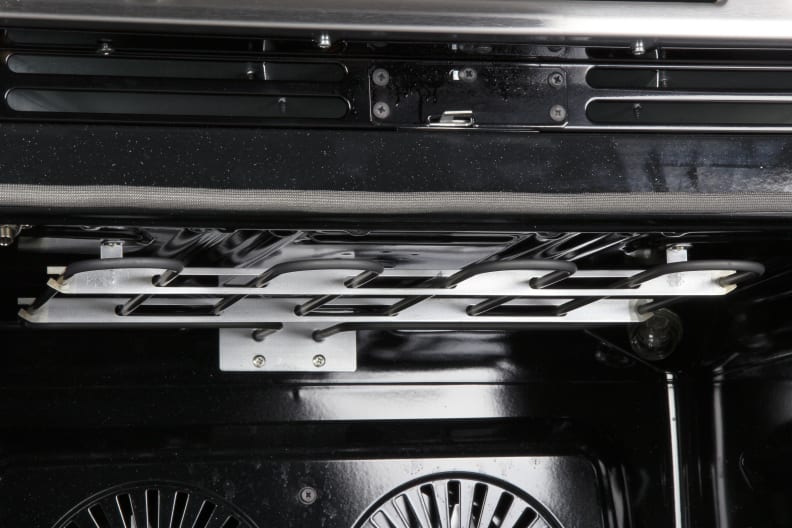
The broiler’s preheat time was impressive, heating the area directly below to 604°F in just under 5 minutes.
The broiler’s preheat was impressive, reaching 604°F in just under five minutes. The time it took to preheat the entire cavity to 350°F was less impressive, but not bad: You’ll have to wait almost 11 minutes using the standard bake setting, and two minutes longer if you’re using convection.
Warranty
Kenmore offers a 1-year limited warranty for this range. For one year from the time of purchase, Kenmore will offer repairs or replacements to this range if it’s found to be defective in material or workmanship. Just be sure to have a proof of sale handy.
Why We Like It
Tough competition
There’s not much to dislike about the Kenmore Elite 41313. It’s sleek, fairly speedy, and full of bake options. The oven has some issues with even heating but is capable of great things, while the rangetop puts sizzlingly high and astoundingly low temperatures within reach. Those are all the ingredients you need to create a great range—and cook a great meal.
So, why don't we love it? Unfortunately, its competitors are just as good, but cost far less. Unless Kenmore drops the price on the 41313, you should check out similarly styled ranges from LG and Samsung.
From the Lab
Sale price aside, we put the Kenmore Elite 41313 electric range through its paces in our lab, testing everything from how quickly it can boil water to how evenly it can bake a sheet of cookies. The range wasn’t perfect, but it came pretty darn close: Test results were quite impressive—in fact, a little too impressive.
Oven & Broiler Performance
Our real-world baking tests allow us to see how an oven can handle actual food. We tried out the 41313’s standard Bake setting, as well as Convection Bake, and found the oven extremely capable.
A sheet of cookies baked at the standard setting had pale, barely browned tops and golden bottoms—a delicious pattern that was repeated evenly across the cookie sheet.

The 4.6 cubic-foot oven may be on the small side, but what it lacks in size it makes up for in cooking performance.
The two cakes we baked side by side using the Bake setting, however, did not fare so well. Browning was even enough within each individual cake, but the left cake was darker on the bottom than the right, indicating uneven heat throughout the cavity over time.
The convection setting, however, improved matters. We measured very little variation in doneness between the tops and bottoms of the cookies, and again this was uniform across the cookie sheet. The bottom of the left cake was still darker than the right, but convection improved it very slightly. The tradeoff, however, was that there was also a bit more variation in browning among each individual cake. Overall, we’d say these effects are fairly negligible. If you’re baking an item for a longer period of time, you may want to consider turning your pan 180° halfway through baking to counteract the left-right unevenness.

The broiler’s preheat time was impressive, heating the area directly below to 604°F in just under 5 minutes.
When it came to roasting, the pork loin we roasted using the standard Bake setting earned high marks for moisture, only losing 0.66 lbs. of water during its quick 31 minutes per l lb. cook time. However, browning was uneven across the surface of the roast.
The pork we roasted using Convection Roast lost 0.88 lbs. of moisture, making it unpleasantly dry. However, it cooked through in just over 31 minutes, which is quite quick. It also displayed very even browning across its surface.
The broiler heated the area directly below to 604°F in just 4 minutes and 51 seconds. The time it took to preheat the entire cavity to 350 °F was less impressive, but not bad. You’ll have to wait 10 minutes 50 seconds using the standard bake setting, and two minutes longer if you’re using convection.
Rangetop Performance
The 41313 has an wide temperature range and two burners that are lightning fast for boiling.
The left front burner is by far the most versatile, reaching a maximum temperature of 746°F and a minimum temperature of 78°F, and boiling 6 cups of water in just 5 minutes 8 seconds. The issue here, of course, is that 746°F is hotter than you’ll ever need for cooking (and hotter than the flash point of cooking oil). Plus, 78°F is too low to do much in the way of melting, simmering, or any other kind of cooking—but warm enough to allow for bacterial growth if you leave your food on this setting for a number of hours. Keep your temperature selection away from these two extremes and you should be fine.
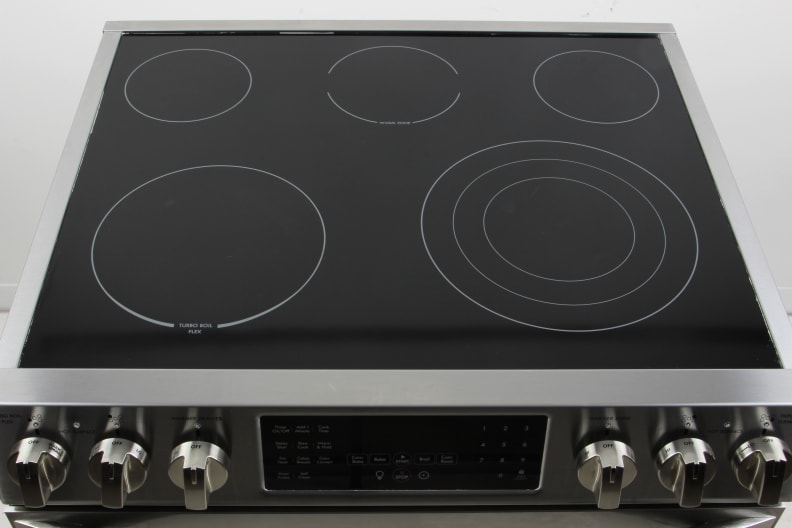
The 41313 has an impressively large temperature reach and two burners that are lightning-fast to boil.
The right front burner’s outer ring was the only one that could boil more quickly than the left front, bringing 6 cups of water to a boil in just 3 minutes and 38 seconds. It maxed out at 641°F during our 5 minute max temperature test, and reached its lowest heat at 150°F. The burner’s middle-sized ring was able to get hotter, hitting 649°F, while the smallest inner ring was able to hit a slightly lower minimum temp of 149°F.
Apart from the left front burner, burners reached their lowest temperatures between 105°F (left rear burner) and 151°F, appropriate for simmering and melting.
{{ photo_gallery name="Charts" }}
Every burner had a scalding max temp, with all but the left front burner hitting their highest temperatures between 629°F (right front burner, inner ring) and 696°F (right rear burner). Impressive? Yes, but make sure you don't burn your food.
Also worth noting: While the left and right front burners had extremely fast boil times, the left rear burners are nowhere near as speedy. Stick to the front of the range when you’re boiling and you shouldn’t have a problem.
Meet the tester
Kori began her journalism career as a teenage fashion blogger and has enjoyed covering a wide variety of topics ever since. In her spare time, she’s an amateur poet, avid reader, and gluten-free cake baker extraordinaire.
Checking our work.
Our team is here to help you buy the best stuff and love what you own. Our writers, editors, and experts obsess over the products we cover to make sure you're confident and satisfied. Have a different opinion about something we recommend? Email us and we'll compare notes.
Shoot us an email